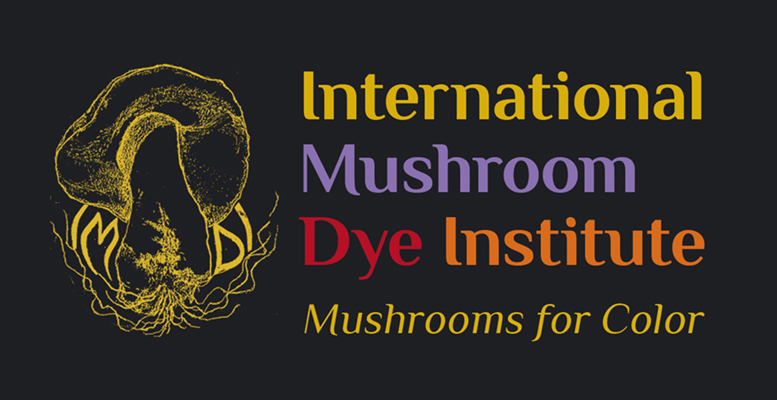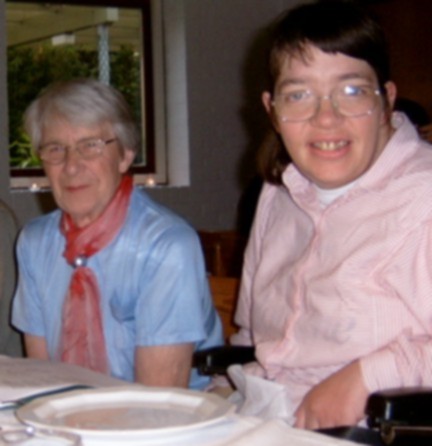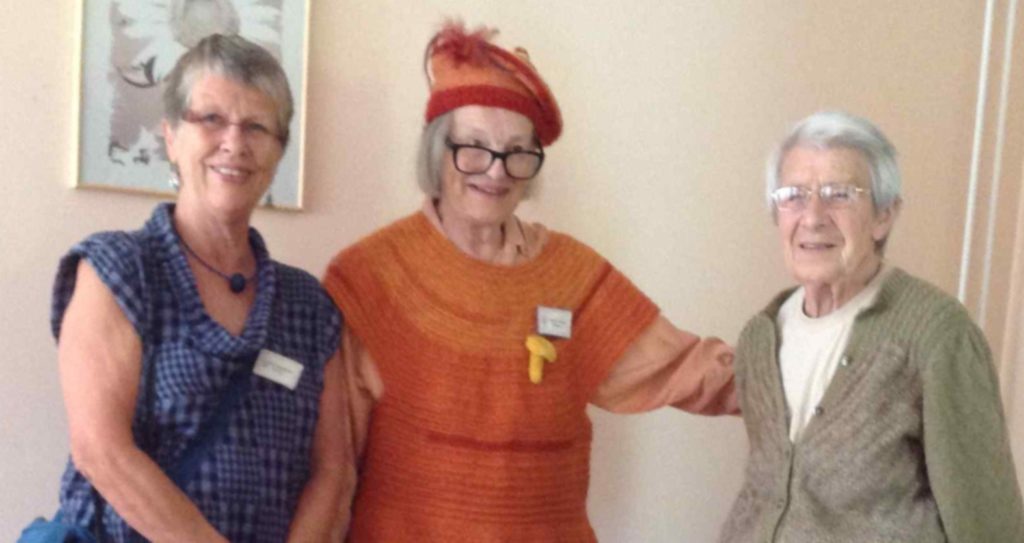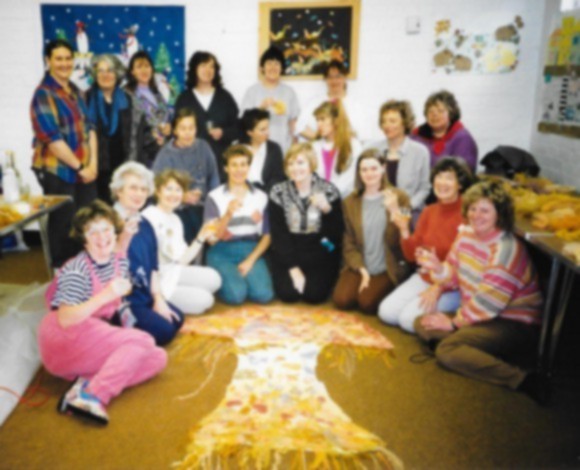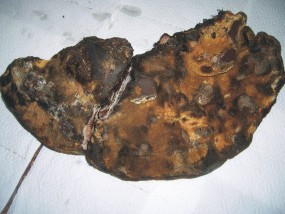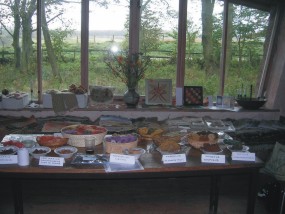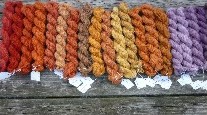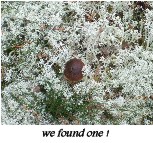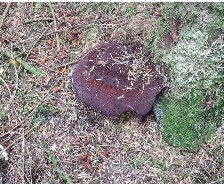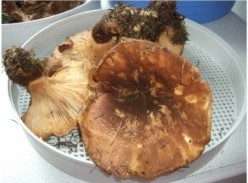International Fungi & Fibre Newsletter 2019
SCOTLAND ~ Marilyn Caddell
Greetings from Scotland. It is hard to believe that it is 26 years since we hosted the 6th IFFF symposium here in Edinburgh in 1993. Back then the Scottish Fungi Group had a good number of members, which has sadly diminished. We really miss Jeanette McKeown, and also Irene Taylder who died earlier this year. On the plus side we have welcomed Veronica Collins. Over the years, sometimes together with Irene and Carole Thorpe from England, we have made group exhibits to take to the various IFFF Symposia. Recently the Tolbooth building in Lanark, the town where I live, was renovated and made into a community hub and exhibition gallery. I suggested that it would be great to put on an exhibition of our work for the general public to see the fantastic colours that some fungi contain – if we can find the right ones!

This we did from August 25th to 9th September, calling the exhibition “Fabulous Fungi Dyes”. Four of us set it up – Trisha Gow, Su Grierson, Veronica and myself. As well as group exhibits and some of our own work we received items made by Fiona Moir, Irene Taylder, Carole Thorpe and Anna King. Plus posters from Liza Johansson in Sweden showing her use of fungi dyes for making paints and Ninela Ivanova from Bulgaria (now living in England) showing her fungi dye use in her fashion design. Our first group exhibit was a 7 foot felted Magic Mushroom to take to the 1995 symposium in Sweden. We joined the Scottish Felters and spent a fun weekend creating it. The basic mushroom shape, white with a red cap, was covered with a myriad of small fungi shapes and was a kaleidoscope of colour.

Then for the 1997 symposium at Lake Saranac in USA we decided to make The Fungi Quilt. Seven of us took over 400 hours to make it! The central panel is made up of 9” wool squares dyed green, yellow, gold, orange and purple, with the stitching representing Scottish thistles and the traditional Luckenbooth motif. The centre square has our initials, the date and Hale Bop – the comet that went across the sky that year.
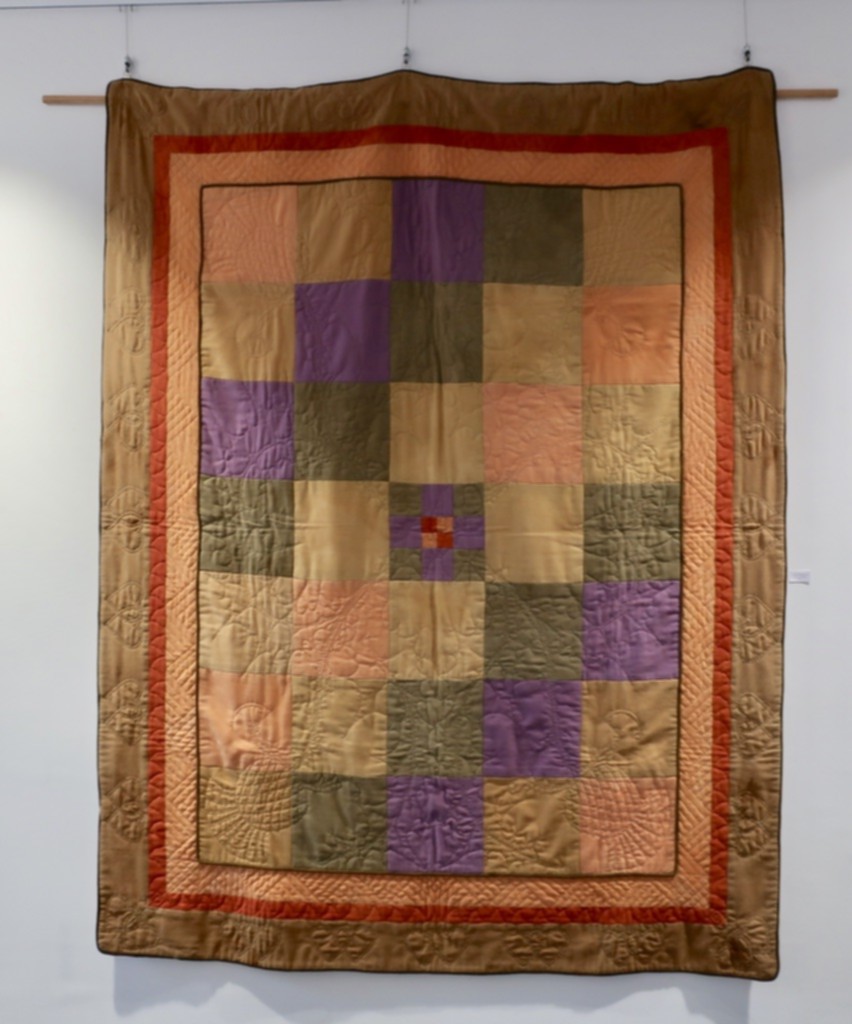
At the 2001 symposium in Finland we dyed 15 silk scarves . The aim was to get as strong a colour as possible from the dye baths.
They hung from the ceiling on two wooden frames and looked stunning, the shimmering silk highlighting the beautiful colours.

Some years we made individual items with a common theme e.g. using only one mushroom to obtain all the colours; each having four 4” blocks of wood to cover the surface in fabric/felt as a set; and making sporrans to take to Australia in 2003, wearing them to the dinner on the last night.
Other individual exhibits included the following Trisha Gow – beautiful tapestry woven pieces “Dye Sampler” and “Mushroom Landscape”; Veronica Collins – Tapestry woven hangings “Shetland Sunset” and “Wood Wide Web”; Anna King – boxed Rolls of Fungi Colours; Fiona Moir – Pin Wheel Weave Stole and long scarf in shades of purple and Irene Taylder and Carole Thorpe – dyed silk stained glass windows. Marilyn Caddell – felt “Fungi Fantasy” and 2 embroidered flower pictures
We invited Ninela to give a talk about her work with fungi “Fungi for Material Futures”. As a designer she is interested in sustainability and zero waste fashion, and using mycelium structures to produce textiles. She is working with a furniture maker, Sebastian Cox, who has a small area of woodland. They are experimenting with using bracket fungi and mycelium to make furniture instead of chopping down trees. She gave a slide presentation of this work at the last symposium in Norway, showing the stools and lampshades they are producing.
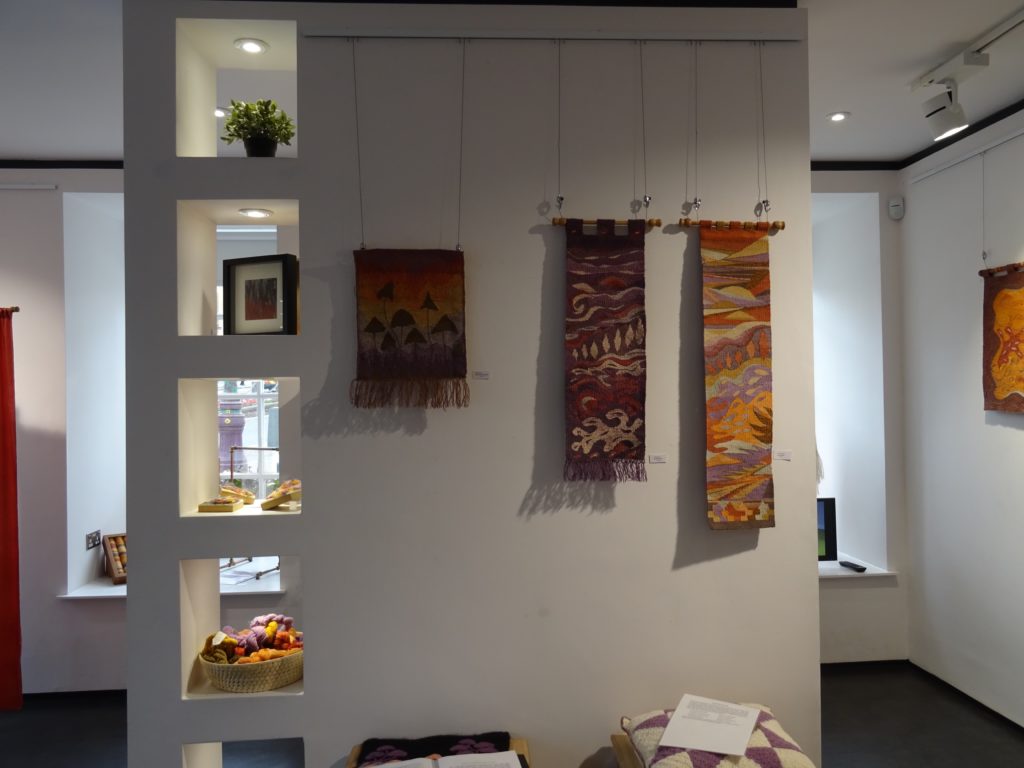
We had lots of lovely comments in the visitors’ book at the exhibition. All The folk who came to see the exhibition were totally amazed by the beauty and wide range of the colours that certain species of fungi can yield – from the subtle greens and yellows to the vivid reds and purples. When I give talks to groups I always get the same reaction, especially when they see Hapalopilus nidulans – how can a small brown bracket fungi give such a vivid purple colour? Do we know how it was discovered that it would react with ammonia to give purple? Was a piece on the ground, an animal urinated on it and someone noticed the reaction? Or was a mushroom expert testing different fungi with acidic and alkaline solutions? Cortinarious semisanguineus is fantastic, too. Two colours in one small mushroom, red in the cap and orange in the stem. So many potential colours. As our exhibition title says – Fabulous Fungi Dyes indeed!
We are really looking forward to seeing you all next year in Port Townsend.
Marilyn Caddell
Memories of Janette McKeown , by Marilyn Caddell, Scotland
Sadly we have only recently learned that Janette died a few months ago. Many of you will remember her and her daughter, Eleanor, in a wheelchair. Janette was widowed many years ago and as she put her son through agricultural college she asked Eleanor what she would like to do. “Go round the world in 80 days” Eleanor replied. Well, it took rather more than that, but the two of them traveled extensively to many countries, including most of the fungi symposia venues since the Scottish one in 1993.
Newsletter #2 from SCOTLAND 2012 by Marilyn Caddell & Trisha Gow
SPREADING THE WORD- During the past two years I have been spreading the word about the magic of fungi dyes, giving talks to various groups and exhibiting items made from fungi dyed yarn, fleece, etc. On the way back from one of these trips to the south of England we stopped to visit a friend. She had a lovely surprise for me – a huge Inonotus hispidus on one of her ash trees. As it had rained a lot in the previous weeks it contained a lot of moisture, so it took me quite a while to cut it up and dry it – but what a lot of dye potential ! I know I can re-use the same piece several times and still get a good colour – a wonderful range of golds, oranges and greens.
Last September Janette McKeown and I went over to Belfast, Northern Ireland, to lead a two day workshop for the Northern Ireland Guild of Weavers, Spinners and Dyers. Day one was taken up with dyeing hanks of yarn so that all the participants could take away a sample card and use the remaining yarn for a guild project. They were all totally amazed at the variety and vibrancy of the colours. On the second day Janette showed them how to make cobweb felt scarves from merino tops and apply dyes with syringes and foam pads. We definitely ended the weekend with many converts who will be scouring their local woods each autumn for fungi!
My greatest challenge was a workshop that I led in October at a 60 acre community wood called Pishwanton, to the east of Edinburgh. It is owned by the Life Science Trust. They run courses on environmental and ecological life style and all the animals and plants are strictly organically raised. There is no electricity, no running water and the building we worked in had a turf roof. It was beautiful inside, with big arched windows, a stone wood burning stove, lots of spinning wheels and some looms. The two ends of the building were open to the elements at the front and were used for the carpentry involved for the new buildings.
There was only one composting loo, set apart in among the trees, so we were careful not to drink too much! NOTHING could be discarded or emptied onto the soil, so in advance of the workshop I had to gather together camping gas burners to cook up the dyes, and dozens of plastic milk bottles to take away all rinsing water and excess dye liquid. Packing everything, including all the pots and pans, into the car was a work of art. We had hoped to work outside and heat some of the dye pots over an open fire, but, of course, it rained all day, so we had to use the woodworkers quarters. It was a squash with so many pots on the go and bodies squeezed in, but we had a lot of fun, and everyone went home happy with their sample cards and brightly coloured skeins.
Now I am looking forward to the next Fungi and Fibre Symposium in Spain in October, meeting up with ‘old’ friends, learning new skills and exploring a new part of the world. See you there! ~ Marilyn Caddell
n October 2011, I was invited to give a talk & do a sample workshop for the Berkshire Guild of Weaving Spinning & Dyeing. Carole Thorpe and Irene Taydler came along to help and we produced this selection of small samples using Innonotus Hispidus, Hapilopilus nidulans and C. semi-sanguineus. Some very enthusiastic people were also able to take home the residue dye for their own use!
Carole and I then joined Monika Brown at her home in Sweden for a few days mushrooming. Unfortunately for us there were not many mushrooms left but we had lots of fun. We are hoping to go back sometime- it is just so good to be able to find dye fungi in abundance – we do struggle to find them in the UK. ~Trisha Gow
__________________________________________________________
Newsletter #1 from Scotland by Trisha Gow2011
Marilyn Caddell and I went on a foray on our return from Sweden to Glen Tress near Peebles. This area has been extensively developed for cycling and has rough tracks all over the woods. As a result many of the areas we found dye fungi have gone. We found a few C. semi sanquineus but went back to the tree line, where no-one now goes, to find some Phaeolus schweinitzii and Paxillus atrotomentosus . I also found Phaeolus in my local woods – a good year for it I think.
This autumn Marilyn and Jeanette are planning a visit to Belfast in Northern Ireland to run a fungi dye workshop. Trisha Gow and Carole Thorpe are going to do a fungi dye demonstration for the Berkshire Guild of Weavers Spinners and Dyers (near Oxford, England)
Trisha has been experimenting with solar dyeing using fungi and is just setting up some new jars. This involves mordanting fibres and layering in the fungi and then they sit in the sun! I am going to try some Hapilopilus nidulans and possibly Phaelous schweinitzii to see how the dye / ammonia mixture works!
